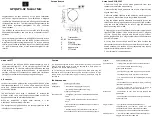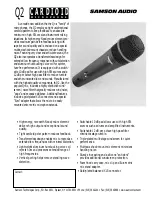
3
1. Kurzbeschreibung
Der Kunstkopf KU 100 ist in seinen Abmessungen
dem menschlichen Kopf nachgebildet und in den
Ohren mit Mikrophonen ausgerüstet.
Zum Abhören der Kunstkopfsignale sollten hoch-
wertige, diffusfeldentzerrte Kopfhörer verwendet
werden. Dann gewinnt man den Eindruck des Da-
beiseins am Ort der Darbietung („Kopfbezogene
Stereophonie“).
Das Klangbild bei Lautsprecherwiedergabe entspricht
weitgehend dem eines herkömmlichen Stereomikro-
phons, jedoch mit differenzierterer Abbildung der
Raumtiefe.
Aufgrund seiner Bauweise eignet sich der Kunstkopf
als Aufnahmesystem und Meßmittel vor allem für
folgende Aufgaben:
•
Hörspiel/Featureproduktionen
•
Konzertmitschnitte und Live-Übertragungen aus
den Bereichen Klassik, Jazz, Pop und Unterhal-
tung
•
Stereoaufnahmen ohne großen Aufwand in aku-
stisch sehr komplexen Räumen – z. B. in Kirchen
•
Dokumentation von Tierstimmen und Naturbil-
dern, von Konferenzen, Theater- und Opernauf-
führungen
•
Einspielkontrolle in Sälen, Theatern und Audito-
rien
•
Dokumentation und Beurteilung der Hörsamkeit
von Räumen wie z. B. Konzertsälen
•
Dokumentation und Beurteilung von Musikinstru-
menten
•
Dokumentation und Beurteilung einer elektroaku-
stischen Übertragungsanlage in Räumen oder auch
in Fahrzeugen (Kommunikationsanlagen, Auto-
lautsprecher)
•
Sprachverständlichkeitsmessungen
•
Dokumentation und Beurteilung der Belästigung
durch Lärm in der Industrie, am Arbeitsplatz und
im Verkehr
•
Messung von (offenen) Kopfhörern
Der Kunstkopf besitzt symmetrische und unsymme-
trische transformatorlose Ausgänge.
1. Overview
The KU 100 dummy head is a replication of the
human head, equipped with microphones within the
“ears”. Listening to recordings made with this sys-
tem through high-quality, diffuse-field equalized head-
phones or analyzing the acoustic data gathered by
the system affords a “listening” impression which
dimensionally recreates the acoustical information
present at the location of the head during the original
acoustical “event” (i.e. ‘Head-Related Stereophony’).
lf reproduced through loudspeakers, the sound im-
pressions are almost identical to those obtained by
means of conventional stereo microphone techniques
with an increased sense of “depth” of the sound-
stage.
Thanks to its design, the dummy head is a suitable
means of recording and monitoring for a number of
applications, in particular:
•
Radio Drama/Feature Productions
•
Recording of concerts and live broadcasts in
the areas of classical music, jazz, pop music, and
entertainment shows
•
Stereo recordings with relatively simple means
in acoustically very complex environments (i.e.
churches, etc.)
•
Documentation of animal voices and natural
sounds, conferences, theater and opera perfor-
mances
•
Monitoring of the effect of P.A. Systems in halls,
theaters, and auditoriums
•
Documentation and assessment of the audibility
conditions of rooms (i.e. concert halls)
•
Documentation and assessment of musical instru-
ments
•
Documentation and assessment of electroacoustic
P.A. Systems in rooms and/or in automobiles
(i.e. evaluation of automotive loudspeakers)
•
Measurement of speech intelligibility
•
Documentation and assessment of noise nuisance
in industry, at workplaces or in traffic
•
Measurement of (open) headphones
The dummy head is provided with balanced and
unbalanced, transformerless outputs.




































